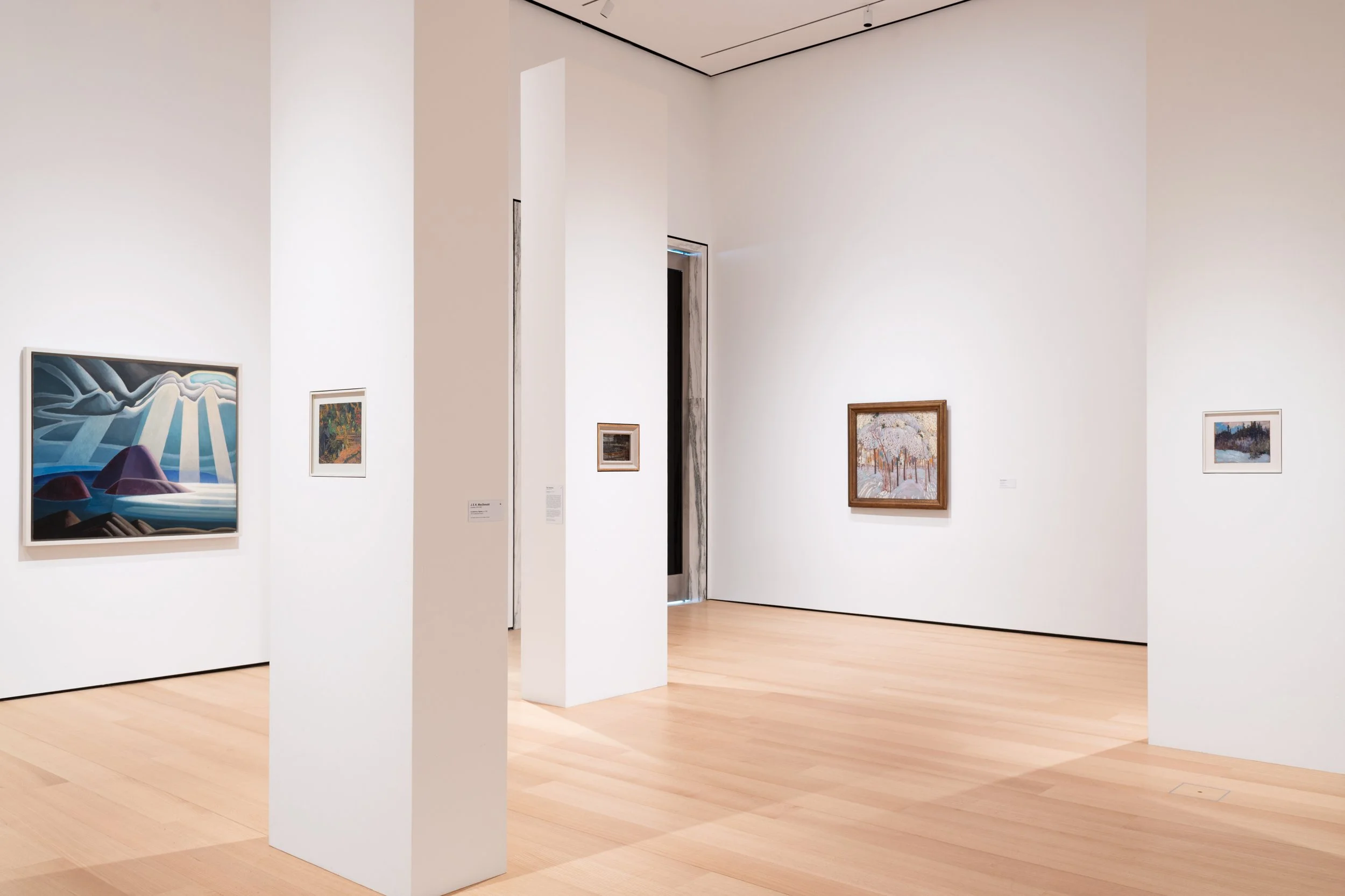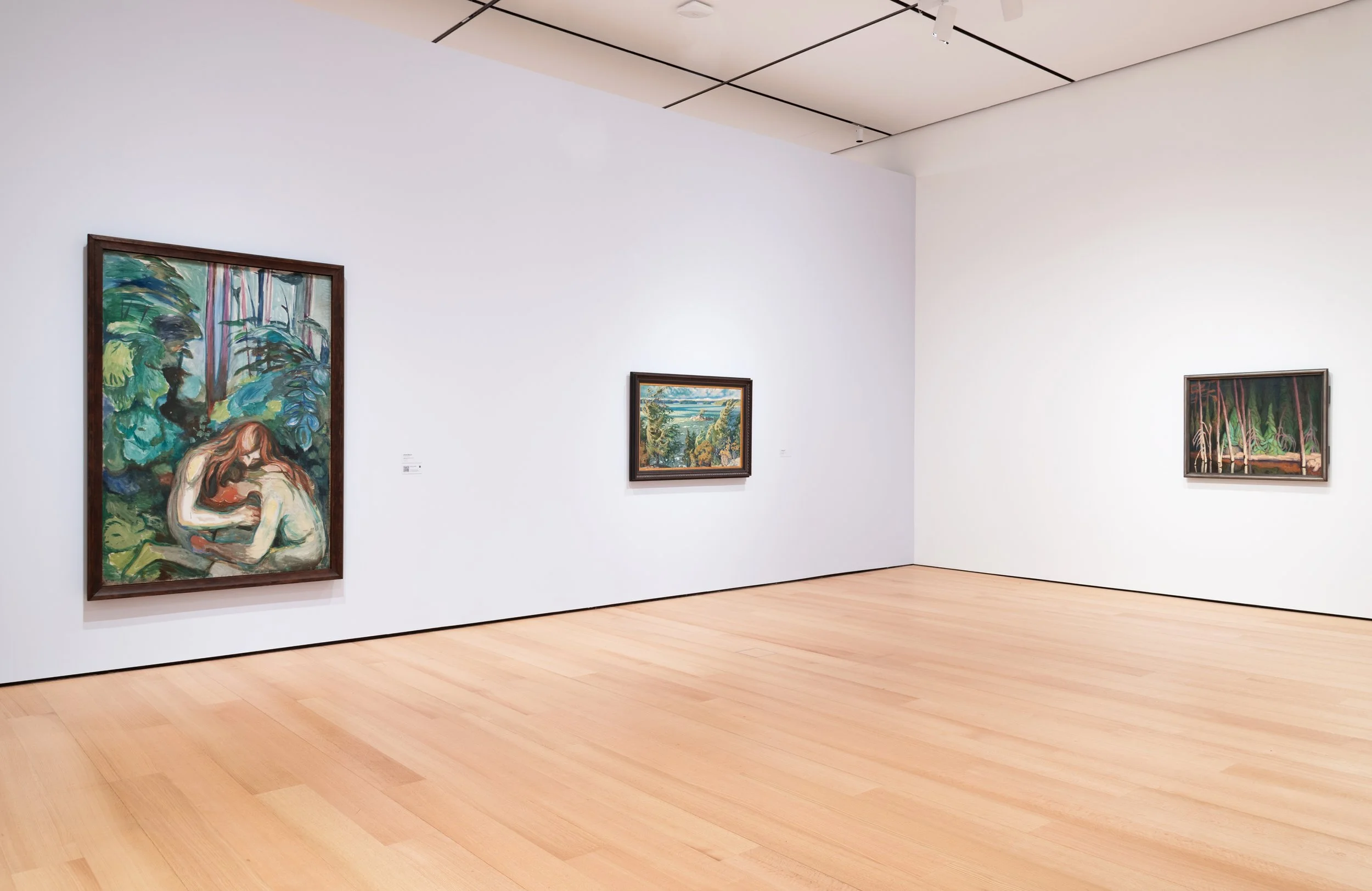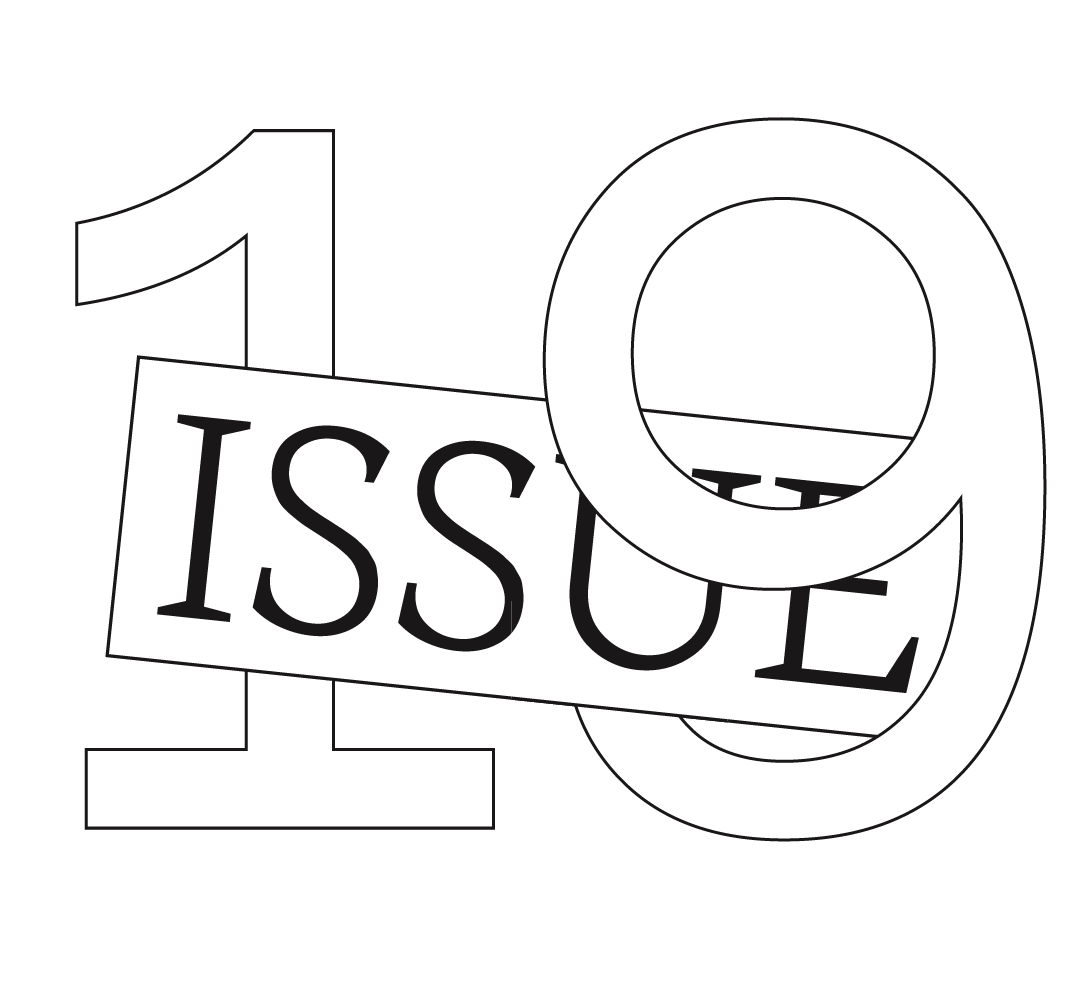Boreal Bonds
Shared Landscapes and Artistic Practice in Canada and the Nordic Regions
Northern Lights, 2025, installation view, Buffalo AKG Art Museum.
Photo: Mark Niedermann.
On August 1, 2025, the Buffalo AKG Art Museum opened Northern Lights, a landmark exhibition bringing together sixty-two landscape paintings from Scandinavia and Canada created between 1880 and 1930. Featuring works by celebrated artists such as Edvard Munch and Hilma af Klint, the exhibition highlights a striking artistic resonance between two geographically distant yet culturally connected regions. What unites them is something deeply elemental: the boreal landscape. This global biome circling the Arctic acts as both backdrop and protagonist in the exhibition’s story of artistic convergence. A shared terrain of vast evergreen forests, glacial lakes, and rugged coastlines illuminated by the elusive light of northern latitudes, it has embedded itself into the artistic consciousness of both Scandinavian and Canadian artists.
This article explores how shared northern geographies foster common visual languages, emotional registers, and even political reflections in the work of artists past and present. Canadian and Scandinavian arts and culture often draw from the ethereal natural landscapes of these regions. The Canadian Shield, an expanse of granite outcrops and dense coniferous forests, echoes terrain in parts of Sweden, Finland, and Norway. Artists in both regions have long engaged the land not simply as subject matter but also as collaborator, conduit, and mirror.
Scandinavia of the late nineteenth and early twentieth centuries witnessed a deepening interest in symbolism and inner life, with nature serving as a gateway to metaphysical questions. Artists like Munch used natural elements (trees, water, light) not just to frame a scene but also to express psychological tension and existential unease. Af Klint, working slightly later, developed a unique vocabulary of abstracted natural motifs to engage with Spiritualist ideas and the invisible energies of the cosmos.
Across the Atlantic, Canadian artists from the Group of Seven also reimagined landscape painting in the first decades of the twentieth century. Lawren Harris, A. Y. Jackson, and their compatriots explored the sublime vastness of the Canadian wilderness, rendering the boreal forest with bold contours and expressive colors. Like their Scandinavian counterparts, they sought more than documentation; they searched for spiritual truths in the natural world.
In both contexts, the boreal landscape operates as an active presence: emotionally resonant, mystically charged, and sometimes overwhelming in its scale and stillness.
Northern Lights, 2025, installation view, Buffalo AKG Art Museum.
Photo: Mark Niedermann.
Northern Lights provides a rare opportunity to view these regional expressions in visual and conceptual dialogue. this cultural overlap invites new readings of these works, asking: How did artists across the Atlantic develop such parallel approaches to landscape, and why? How did they engage with questions of belonging and memory?
There is something more elemental in these works: an emotional attunement to a particular kind of light, to long winters and fleeting summers, to a solitude that is both isolating and generative. The boreal landscape elicits an introspective gaze. It is not a land of spectacle but of slow revelation, a quality shared by many of the paintings in Northern Lights.
While the exhibition includes major figures like Munch and af Klint, it also features lesser-known artists whose works deserve renewed attention. Many of them explored similar techniques—loose brushwork, muted palettes, an emphasis on atmosphere—and thematic concerns such as the passage of time, the transience of light, and the porous boundary between internal and external worlds.
While landscape is perhaps the most visible point of connection, cultural and lifestyle practices also link Canadian and Scandinavian art. Both regions have long histories of closeness to nature, manifested in traditions such as friluftsliv (open-air living) in Norway and Sweden. These philosophies frame nature as something to coexist with, not conquer.
This ethos is visible in the art itself, evinced in an absence of human figures, the prominence of untamed terrain, and a tendency toward introspective mood. Many of these works also share a quietness or humility in the face of the land’s immensity. Artists in both regions explore nature—whether the fjords of western Norway or the lakes of northern Ontario—as a psychological and philosophical landscape as much as a physical one
Northern Lights, 2025, installation view, Buffalo AKG Art Museum.
Photo: Mark Niedermann.
Between 1880 and 1930, both Canada and countries in Scandinavia underwent formative periods of national consolidation. In Canada, the decades following Confederation in 1867 saw the country’s expansion westward, often through violent processes of settler colonialism, displacement of Indigenous nations, and large-scale infrastructure projects like the Canadian Pacific Railway. In Scandinavia, political restructuring, particularly Norway’s independence from Sweden in 1905, spurred a cultural turn inward, as artists and others sought to articulate distinct national identities through language, folklore, and, crucially, visual art.
In this political and cultural context, landscape painting became more than an aesthetic enterprise: It became a mechanism for imagining the nation. Artists did not just represent the land; it was also claimed, idealized, and mythologized.
In Canada, the Group of Seven played a central role in shaping this nationalist visual lexicon. Their depictions of the boreal wilderness as uninhabited, monumental, and spiritually charged projected an image of Canada as a land of raw natural power, a young nation rooted not in history but in geology and geography. Harris, for example, painted the northern landscape with stark, almost mystical abstraction, rendering mountain peaks and Arctic coasts as symbols of purity and endurance. He and his peers cast the landscape as foundational, timeless, untouched, and resolutely Canadian.
Yet this visual project was also an act of erasure. The wilderness celebrated by the Group of Seven was far from empty; it was Indigenous land, layered with histories and stories that the Group of Seven’s paintings actively excluded. The assertion of Canadian identity through landscape thus relied on the rhetorical conceit of terra nullius, a land without people, ready to be seen, named, and possessed.
A parallel but distinct phenomenon occurred in the Nordic regions. As Norway emerged from union with Sweden and Finland moved toward independence from Russia, artists increasingly turned to nature to articulate national specificity. Norwegian painters such as Harald Sohlberg evoke a mythic, almost eternal vision of homeland in the quiet majesty of the country’s fjords and forests. In Sweden and Finland, artists including Prince Eugen, Duke of Närke, and Akseli Gallen-Kallela developed symbolist-inflected languages of landscape, combining national motifs with metaphysical and folkloric elements. Gallen-Kallela engaged and helped shape Finnish identity through his sprawling landscape paintings and illustrations of the Kalevala, a nineteenth century compilation of folkloric traditions.
Even more spiritually oriented artists, such as af Klint, worked within this atmosphere of nation-building, albeit more obliquely. Her abstracted organic forms and explorations of invisible natural energies, though not overtly nationalist, emerged within a cultural climate increasingly invested in the land as a bearer of collective identity and transcendental meaning.
Northern Lights, 2025, installation view, Buffalo AKG Art Museum.
Photo: Mark Niedermann.
In all these cases, land functions as both canvas and mirror, simultaneously reflecting a desired national self and actively shaping the conception of that self. And paintings of the land, so conceived, served as a visual infrastructure for emerging national consciousness. They offered a language through which artists could articulate not only political sovereignty but also emotional and spiritual connection to place.
In our current moment of planetary instability, the boreal forest is no longer just a cultural touchstone: It is a barometer of environmental collapse. As wildfires rage from British Columbia to Lapland and permafrost thaws at alarming rates, artists are responding to a landscape on the brink.
Danish artist Jakob Kudsk Steensen’s Boreal Dreams, commissioned by Fondation Beyeler, exemplifies this shift. The immersive, interactive installation uses scientific data and dream logic to trace the boreal biome’s transformation. It reimagines the forests of North America and Scandinavia as a site of memory, sleep, and collective dreaming, an archive of environmental trauma and speculative futures.
Like earlier artists, Steensen engages with the metaphysical dimensions of nature. But while af Klint’s work sites spiritual energies within untouched ecosystems, loss and potential extinction haunt Boreal Dreams. It asks not only how we see the land but also how the land sees us, how it infiltrates our subconscious, our language, our sense of time.
Like Steensen, Ane Graff and Hanna Ljungh critique humanity’s exploitation of the natural world. Their work continues the legacy of deep engagement with landscape but from a position of urgency and environmental consciousness.
These contemporary practices suggest that while the aesthetic approaches have evolved, the landscape remains, for many artists, a central interlocutor—albeit one now burdened with new political and ecological meaning. Although the northern regions of the world may not be experiencing as brutal summer temperatures as southern Europe or California, the changes to the environment there are notable and catastrophic. With more extreme weather in the winters and rising sea temperatures, the fragile ecology of the Scandinavia and Canada suffers. The need for Northern artists to highlight these often unseen but devastating changes is all the more pressing.
Northern Lights, 2025, installation view, Buffalo AKG Art Museum.
Photo: Mark Niedermann.
Canada and Scandinavia, though oceans apart, share a geographic lexicon that has profoundly shaped their visual cultures. The boreal forest, in all its stillness and mystery, speaks a common language.
Northern Lights is more than an art historical comparison. It is an invitation to consider how environments shape not only what we see but also how we see and, crucially, what we choose to remember. Through this lens, the landscapes of the North are not just reflections of a past era but also portals into our collective future.
In these shared landscapes, we find the seeds of a deeper cultural kinship, one rooted in snow-covered pines, glacial silence, and the soft persistence of northern light.
by Lina Stenman
Lina Stenman is a Finnish American curatorial master’s student at the University of the Arts London. Her curatorial practice and research focus on memory-based art. She seeks to understand the importance of speech and dialogue within the gallery as a catalyst and curatorial methodology. Her interest in Scandinavian landscape and cultural memory is rooted in her own childhood experiences of the Nordic wilderness.







